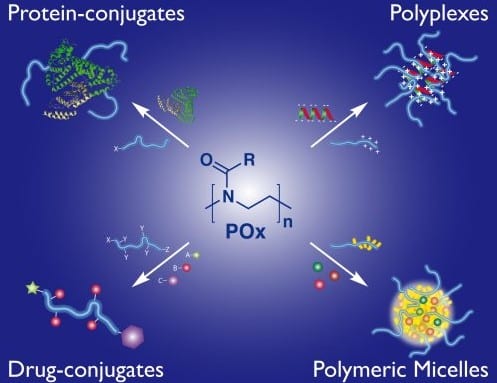 The class of poly(2-oxazoline)s (POx) was first reported in the literature in 1966. Research in this area has been re-stimulated by the introduction of microwave reactors which helped to overcome the problem of long polymerization times.
The class of poly(2-oxazoline)s (POx) was first reported in the literature in 1966. Research in this area has been re-stimulated by the introduction of microwave reactors which helped to overcome the problem of long polymerization times.
Recently POx and related pseudo-polypeptides have been investigated for their great potential in biomedical and life science applications. They are quite readily available, their chemical structures and physical properties can be precisely controlled and adjusted, and they have excellent biocompatibility. One of the current limiting factors is the lack of regulatory approval by the Food and Drug Administration (FDA). Nevertheless, research in this area is rapidly expanding, both synthetically and with regard to applications.
Two of the leading figures in the field of POx, Helmut Schlaad (Max Planck Institute of Colloids and Interfaces, Potsdam, Germany) and Richard Hoogenboom (Ghent University, Belgium) have now guest-edited a special issue to further stimulate research in this exciting area.
Read selected articles now for free!
- The editorial by Schlaad and Hoogenboom gives a brief overview over the entire issue.
- Rainer Jordan and co-workers review Poly(2-oxazoline)s as an upcoming platform for biomaterials design and next-generation polymer therapeutics.
- Robert Luxenhofer et al. investigate highly defined multiblock copolypeptoids derived by sequential polymerization of N-substituted N-carboxyanhydrides.

















